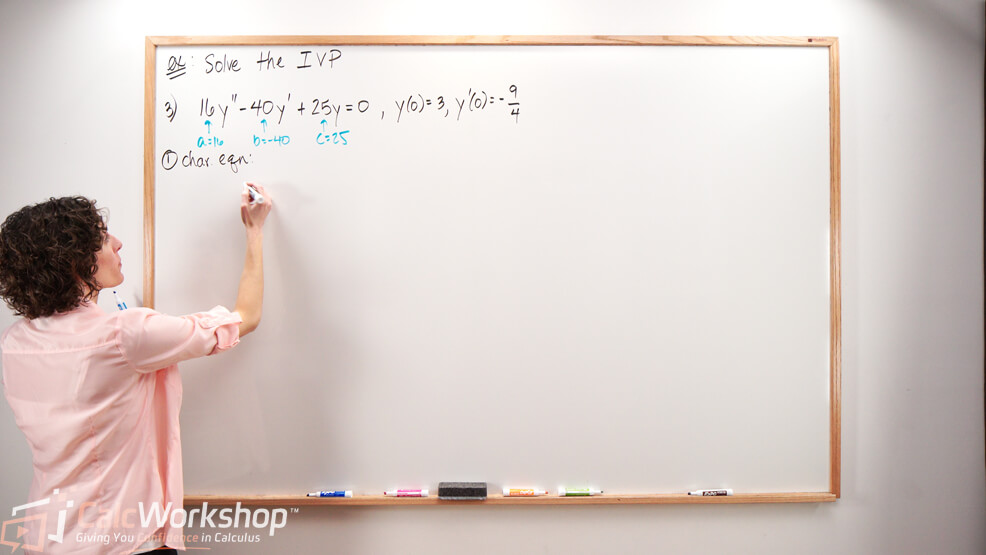Now it’s time for you to focus on solving homogeneous linear and higher-order differential equations with constant coefficients that have repeated roots.

Jenn, Founder Calcworkshop®, 15+ Years Experience (Licensed & Certified Teacher)
This means that after you transform your DE into a characteristic (auxiliary) equation using the principle of superposition, you’ll find that the roots are real but not distinct, as they contain multiplicities.
The great thing is that the process for solving these equations is precisely the same as for distinct and even complex roots — only the general formula is different.
Let’s take a look.
General Formulas for Distinct Real, Complex, and Repeated Real Roots
Remember that when solving a homogeneous linear higher-order differential equation of the form.
\begin{equation}
a_n y^{(n)}+a_{n-1} y^{(n-1)}+\cdots+a_2 y^{\prime \prime}+a_1 y^{\prime}+a_0 y=0
\end{equation}
We first create a characteristic equation.
\begin{equation}
a_n r^n+a_{n-1} r^{(n-1)}+\cdots+a_2 r^2+a_1 r+a_0=0
\end{equation}
And solve for roots.
Distinct Real Roots
\begin{equation}
y=c_1 e^{r_1 t}+c_2 e^{r_2 t}+\cdots+c_n e^{r_n t}
\end{equation}
Complex Roots
\begin{equation}
y=c_1 e^{\alpha t} \cos (\beta t)+c_2 e^{\alpha t} \sin (\beta t) \text {, where } r=\alpha \pm \beta i
\end{equation}
Repeated Real Roots
\begin{equation}
y=\left(c_1+c_2 t+c_3 t^2+\cdots+c_n t^{n-1}\right) e^{a t} \text {, with } r=a \text { repeats } n \text { times }
\end{equation}
Example: Solving a Differential Equation with Repeated Roots
Let’s look at an example.
Suppose we are given the following characteristic equation. Find the general solution of its related differential equation.
\begin{equation}
r^2(r-2)^3(r+5)^4(r+6)=0
\end{equation}
First, we notice that its roots contain multiplicities or repeated roots.
\begin{align*}
r=0(\text { twice }) \quad r=2(\text { three times }) \quad r=5(\text { four times }) \quad r=-6(\text { once })
\end{align*}
So, all this left is for us to plug our roots into the general formula.
\begin{equation}
y=\underbrace{\left(c_1+c_2 t\right)}_{r=0 \text { (twice) }} e^{0 t}+\underbrace{\left(c_3+c_4 t+c_5 t^2\right)}_{r=2 \text { (three times) }} e^{2 t}+\underbrace{\left(c_6+c_7 t+c_8 t^2+c_9 t^3\right)}_{r=5 \text { (four times) }} e^{5 t}+\underbrace{\left(c_{10}\right) e^{-6 t}}_{r=-6(\text { once) }}
\end{equation}
\begin{equation}
y=c_1+c_2 t+\left(c_3+c_4 t+c_5 t^2\right) e^{2 t}+\left(c_6+c_7 t+c_8 t^2+c_9 t^3\right) e^{5 t}+c_{10} e^{-6 t}
\end{equation}
Easy, right?
Example: Combining Formulas for Distinct and Repeated Roots
Let’s look at another example, so we can really confirm all that we’ve learned so far.
Find the general solution of \(y^{(4)}-3 y^{\prime \prime}+2 y^{\prime}=0\)
First, we will transform our DE into the characteristic equation.
\begin{align*}
\begin{aligned}
& y^{(4)}-3 y^{\prime \prime}+2 y^{\prime}=0 \\
& r^{4}-3 r^{2}+2 r=0
\end{aligned}
\end{align*}
Next, we will solve the quadratic polynomial for our roots using factoring and synthetic division \(r^{4}-3 r^{2}+2 r=0\)
\begin{equation}
r\left(r^3-3 r+2\right)=0
\end{equation}
\begin{equation}
r(r-1)^2(r+2)=0
\end{equation}
\begin{align*}
r=0 \quad r=1(\text { twice }) \quad r=-2
\end{align*}
So, we have two distinct roots \((r=0\) and \(r=-2)\) and one repeated root \((r=1)\). So we must combine our general formula for distinct roots with repeated roots.
\begin{align*}
\begin{aligned}
& y=\underbrace{\left(c_{1}\right) e^{0 t}}_{r=0}+\underbrace{\left(c_{2}+c_{3} t\right)}_{r=1(\text { twice) }} e^{1 t}+\underbrace{\left(c_{4}\right) e^{-2 t}}_{r=-2(\text { once })} \\
& y=c_{1}+\left(c_{2}+c_{3} t\right) e^{1 t}+c_{4} e^{-2 t}
\end{aligned}
\end{align*}
See! Nothing to it!
Upcoming Lessons and Non-Constant Coefficients
So, we’ve reached the end of our exploration on solving homogeneous second-order and higher-order differential equations with constant coefficients. You may wonder, what do we do when the coefficients are not constant, or when the differential equation is non-homogeneous?
In future lessons, we’ll learn how to solve nonhomogeneous second-order and higher-order differential equations, which involve techniques such as:
As for non-constant (variable) coefficients, that requires a method called Reduction of Order, which we touched on briefly in our lesson on distinct roots.
A crucial question we’ll address is: How do we find the second solution? The main idea is that if you know one solution to a second-order homogeneous differential equation, you can leverage that knowledge to find a second, independent solution.
Following Paul’s Online Notes, the Reduction of Order method involves:
- A change of variables
- An integrating factor
We’ll go through the steps systematically, using several examples, so you can apply this method to find solutions for second-order differential equations with constant or non-constant coefficients.
Next Steps
We will walk through the steps methodically, using several examples, so we can apply this method to find a solution to a second-order, constant, or non-constant coefficient differential equation as we continue to build and expand upon this really cool technique.
Let’s jump right in!
Video Tutorial w/ Full Lesson & Detailed Examples

Get access to all the courses and over 450 HD videos with your subscription
Monthly and Yearly Plans Available
Still wondering if CalcWorkshop is right for you?
Take a Tour and find out how a membership can take the struggle out of learning math.